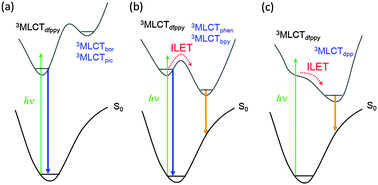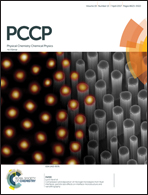The effect of interligand energy transfer on the emission spectra of heteroleptic Ir complexes†
Abstract
In order to understand the causes of the emission shape and colour changes of heteroleptic Ir3+ complexes containing 2-(2,4-difluorophenyl)pyridine (dfppy) as the main ligands, we introduced two types of ancillary ligands: (1) non-luminescent ancillary ligands, namely tetrakis(pyrazolyl)borate (bor) and picolinate (pic), which were employed for the preparation of Ir(dfppy)2(bor) and Ir(dfppy)2(pic), respectively, and (2) luminescent ancillary ligands, namely 1,10-phenanthroline (phen), bipyridine (bpy), and 2,3-dipyridylpyrazine (dpp), which were employed for the preparation of Ir(dfppy)2(phen), Ir(dfppy)2(bpy), and Ir(dfppy)2(dpp), respectively. In a glassy matrix at 77 K, the Ir complexes showed well-structured emission spectra, except Ir(dfppy)2(dpp). The vibronic structures in the emission spectra of Ir(dfppy)2(bor) and Ir(dfppy)2(pic) were maintained even at 300 K. However, Ir(dfppy)2(phen), Ir(dfppy)2(bpy), and Ir(dfppy)2(dpp) showed markedly red-shifted and broad emission spectra. The anomalous rigidochromism was attributed to an interligand energy transfer (ILET), and showed a strong temperature dependence. The excited states of dfppy are higher than those of phen, bpy, and dpp; thus, ILET occurs from dfppy to the other ligands lying in lower energy states. The ILET dynamics were probed directly using femtosecond transient absorption (TA) spectroscopy after the excitation of dfppy. As the time delay increased, the intensity of the TA band of dfppy decreased, while those of the bands related to the phen, bpy, and dpp ancillary ligands increased. On the other hand, no changes in the TA spectra were observed for Ir(dfppy)2(bor) and Ir(dfppy)2(pic). The TA spectral behaviours can be explained in terms of the relative ordering of the emissive states for cyclometalating and ancillary ligands.



 Please wait while we load your content...
Please wait while we load your content...